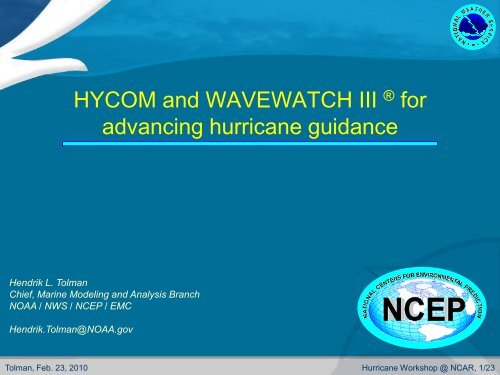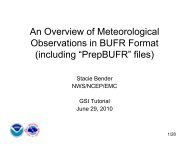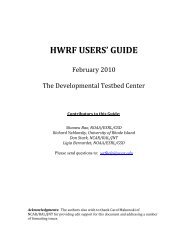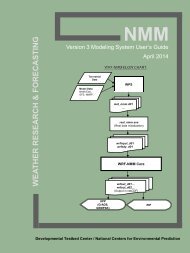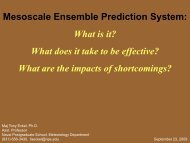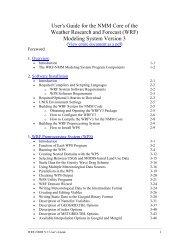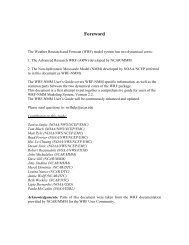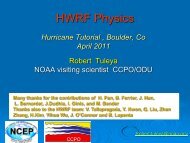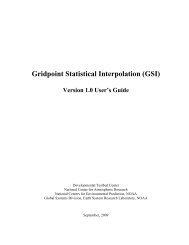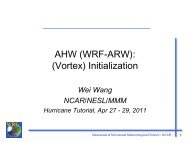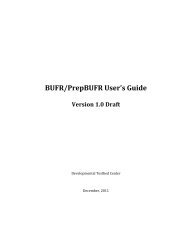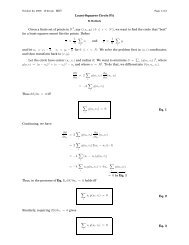HYCOM and WAVEWATCH III ® for advancing hurricane guidance
HYCOM and WAVEWATCH III ® for advancing hurricane guidance
HYCOM and WAVEWATCH III ® for advancing hurricane guidance
You also want an ePaper? Increase the reach of your titles
YUMPU automatically turns print PDFs into web optimized ePapers that Google loves.
<strong>HYCOM</strong> <strong>and</strong> <strong>WAVEWATCH</strong> <strong>III</strong> ® <strong>for</strong><br />
<strong>advancing</strong> <strong>hurricane</strong> <strong>guidance</strong><br />
Hendrik L. Tolman<br />
Chief, Marine Modeling <strong>and</strong> Analysis Branch<br />
NOAA / NWS / NCEP / EMC<br />
Hendrik.Tolman@NOAA.gov<br />
Tolman, Feb. 23, 2010 Hurricane Workshop @ NCAR, 1/23
Overview<br />
• Why coupling?<br />
• Why <strong>HYCOM</strong><br />
• Why <strong>WAVEWATCH</strong> <strong>III</strong>.<br />
• Progress at NCEP<br />
<strong>HYCOM</strong> - HWRF.<br />
<strong>HYCOM</strong> – <strong>WAVEWATCH</strong> <strong>III</strong> - HWRF.<br />
• Computational costs.<br />
• Risks.<br />
• Outlook.<br />
Tolman, Feb. 23, 2010 Hurricane Workshop @ NCAR, 2/23
Why coupling<br />
See many of the other presentations<br />
at this workshop !<br />
Not just <strong>for</strong> <strong>hurricane</strong> <strong>guidance</strong> !<br />
• Weather-ocean coupling proven concept:<br />
Hurricanes (starting with GFDL-POM coupling).<br />
Seasonal <strong>for</strong>ecasting.<br />
• Also potential benefit <strong>for</strong> many of other models.<br />
Ocean circulation, waves, inundation (salt + fresh<br />
water), ecosystems, ….<br />
NCEP, NOS, OAR, OHD, ….<br />
Navy, USACE, USGS, ….<br />
Tolman, Feb. 23, 2010 Hurricane Workshop @ NCAR, 3/23
Why coupling<br />
Wind waves are at the center of many of the<br />
physical processes at the water-air interface.<br />
• Impact all fluxes, fluxes linked through sea spray.<br />
• Waves as direct source to TKE in air <strong>and</strong> water.<br />
• Non-local momentum transfer from atmosphere to ocean.<br />
• Forcing inside boundary layers, not only at the interface.<br />
This is not new:<br />
• Decade of experience with impact on surface stresses <strong>for</strong><br />
weather modeling (ECMWF).<br />
• Decades of experience with impact of currents on waves.<br />
• Decades of experience with wave-surge <strong>and</strong> wavecirculation<br />
linkage<br />
Tolman, Feb. 23, 2010 Hurricane Workshop @ NCAR, 4/23
Why <strong>HYCOM</strong><br />
GFDL-POM <strong>and</strong> HWRF-POM are proven<br />
systems. Why transition to <strong>HYCOM</strong>?<br />
• Scientific / technical issues:<br />
Use operational RTOFS-Atlantic model <strong>for</strong> IC <strong>and</strong> BC:<br />
•Realistic real-time ocean (previous TCs).<br />
Full ocean model:<br />
•Separate support community.<br />
•Solid base <strong>for</strong> physics based improvement.<br />
• Management of NCEP production suite:<br />
No support (at NCEP) <strong>for</strong> further development of POM<br />
based system.<br />
Cannot af<strong>for</strong>d to maintain multiple systems (if not MME).<br />
Tolman, Feb. 23, 2010 Hurricane Workshop @ NCAR, 5/23
Why <strong>WAVEWATCH</strong> <strong>III</strong><br />
<strong>WAVEWATCH</strong> <strong>III</strong> is NCEPs main wave model:<br />
• Consolidation of all wave modeling in single model since<br />
mid 1990’s<br />
Traditional deep ocean, applicable to surf zone.<br />
Close to single wave scale.<br />
• Has become a de-facto community operational <strong>and</strong><br />
research model.<br />
• Traditional use as a <strong>guidance</strong> model at NCEP, but also to<br />
be supported by NCEP <strong>for</strong> local applications at WFOs <strong>and</strong><br />
any interested partner:<br />
“Workstation WW <strong>III</strong>” under development.<br />
Tolman, Feb. 23, 2010 Hurricane Workshop @ NCAR, 6/23
<strong>HYCOM</strong> – HWRF<br />
NCEP progress<br />
• System reaching maturity at the end of 2008.<br />
Initial development not with operational HWRF:<br />
•Needing H050 baseline <strong>for</strong> sensible coupling.<br />
•HR issues.<br />
• Parallel testing with frozen system <strong>for</strong> 2009 Atlantic<br />
Hurricane Season:<br />
Goal: Show potential impact of POM-<strong>HYCOM</strong><br />
replacement.<br />
Compare to operational HWRF.<br />
• In pre-ops testing <strong>for</strong> possible 2010 operational<br />
implementation.<br />
Fully integrated with HWRF development path.<br />
Goal: Replacing POM with <strong>HYCOM</strong> should do no harm.<br />
Tolman, Feb. 23, 2010 Hurricane Workshop @ NCAR, 7/23
HWRF-<strong>HYCOM</strong><br />
RTOFS-Atlantic<br />
(<strong>HYCOM</strong>–Basin):<br />
O(4~17 km)<br />
GFS: O(25 km)<br />
meld<br />
IC<br />
BC<br />
Data Assimilation<br />
(SST, SSH, T&S)<br />
using 2D/3DVAR<br />
Feature Model<br />
Wind<br />
OCEAN:<br />
<strong>HYCOM</strong>–Regional:<br />
O(8~14 km)<br />
SST<br />
* Wind-stress<br />
* Heat Fluxes<br />
* Precipitation<br />
* Atm. Pressure<br />
ATMOS.:<br />
HWRF<br />
O(9 & 27 km)<br />
Tolman, Feb. 23, 2010 Hurricane Workshop @ NCAR, 8/23
HWRF-<strong>HYCOM</strong><br />
Tolman, Feb. 23, 2010 Hurricane Workshop @ NCAR, 9/23
HWRF-<strong>HYCOM</strong><br />
Real time testing<br />
<strong>for</strong> 2008 <strong>hurricane</strong><br />
season (Ike).<br />
subinertial waves<br />
Realistic Oceanic<br />
Simulation <strong>and</strong><br />
Response to a<br />
Storm!<br />
Cold wake<br />
Tolman, Feb. 23, 2010 Hurricane Workshop @ NCAR, 10/23
HWRF-<strong>HYCOM</strong><br />
Overall 2009 real-time parallel results<br />
Two populations due to several short weak systems<br />
Green: NCO operational POM-HWRF<br />
Black: parallel POM-HWRF<br />
Red: parallel <strong>HYCOM</strong>-HWRF<br />
Identical HWRF<br />
Tolman, Feb. 23, 2010 Hurricane Workshop @ NCAR, 11/23
HWRF-<strong>HYCOM</strong> pre-ops testing<br />
Name Date Wind Pressure Category<br />
Fay (06L) 15 – 24 Aug. 2008 60 985 TS<br />
Gustav (07L) 25 Aug. – 1 Sep. 2008 135 940 4<br />
Hanna (08L) 28 Aug. – 7 Sep. 2008 75 977 2<br />
Ike (09L) 1 – 14 Sep. 2008 125 935 4<br />
Bill (03L) 15 – 24 Aug. 2009 115 945 4<br />
Danny (05L) 26 – 29 Aug. 2009 50 1005 TS<br />
Erika (06L) 1 – 4 Sep. 2009 50 1004 TS<br />
Fred (07L) 7 – 12 Sep. 2009 105 958 3<br />
Henri (10L) 6 – 8 Oct. 2009 45 1005 TS<br />
Ida (11L) 4 – 10 Nov. 2009 90 978 2<br />
Tolman, Feb. 23, 2010 Hurricane Workshop @ NCAR, 12/23
HWRF-<strong>HYCOM</strong><br />
2010 pre-ops testing<br />
No GFS res. incr.<br />
Green: Operation 2009 HWRF model.<br />
Red: New baseline HWRF model (H050)<br />
Purple: 2010 test package (POM) (H054)<br />
Orange: 2010 test package (<strong>HYCOM</strong>) (HYC2)<br />
Tolman, Feb. 23, 2010 Hurricane Workshop @ NCAR, 13/23
NCEP progress<br />
<strong>HYCOM</strong> – <strong>WAVEWATCH</strong> <strong>III</strong> – HWRF<br />
• Framework <strong>for</strong> three-way coupling build at NCEP.<br />
• Transitioned to URI <strong>for</strong> insertion of coupling physics.<br />
• Intended <strong>for</strong> real-world testing at end of year.<br />
Tolman, Feb. 23, 2010 Hurricane Workshop @ NCAR, 14/23
URI / ESRL / NCEP / NRL<br />
Coupled Hurricane-Wave-Ocean Framework<br />
• Implemented in GFDL model in a research mode.<br />
• Being implemented in HWRF-WW3-<strong>HYCOM</strong>.<br />
(from Isaac Ginis)<br />
Tolman, Feb. 23, 2010 Hurricane Workshop @ NCAR, 15/23
NCEP progress<br />
“Workstation WW <strong>III</strong>”<br />
• Coupled ADCIRC-WW <strong>III</strong> capability, integrated in<br />
operational WW <strong>III</strong>, can be run locally.<br />
Adding NOS ADCIRC models to NCO operation.<br />
• HFIP funding through NOS.<br />
Work now starting, test version available 2011.<br />
• First as st<strong>and</strong>-alone coupled model.<br />
• Could become blueprint <strong>for</strong> coupled wave-surge modeling in<br />
coupled HWRF.<br />
Tolman, Feb. 23, 2010 Hurricane Workshop @ NCAR, 16/23
Computational costs<br />
Is coupling too expensive <strong>for</strong> operations ?<br />
• <strong>HYCOM</strong> requires significantly<br />
less resources than HWRF.<br />
• POM typically is run on only one<br />
process:<br />
<strong>HYCOM</strong> much more<br />
expensive than POM, but<br />
this does not mean that<br />
<strong>HYCOM</strong> dominates<br />
resource requirements.<br />
• Adding the wave model later<br />
requires only 20% of <strong>HYCOM</strong><br />
resources or 7% of HWRF<br />
resources<br />
assigned resources<br />
in test setup<br />
model<br />
processes<br />
HWRF 91<br />
<strong>HYCOM</strong> 30<br />
WW <strong>III</strong> 6<br />
But this is not the<br />
whole story, what is<br />
the run time ?<br />
Tolman, Feb. 23, 2010 Hurricane Workshop @ NCAR, 17/23
Computational costs<br />
Is coupling too expensive <strong>for</strong> operations ?<br />
• There are 20 nodes available <strong>for</strong> operational HWRF model.<br />
• We believe we can fit <strong>HYCOM</strong>-HWRF on 4 nodes fitting in<br />
the allotted time window.<br />
<strong>HYCOM</strong>-HWRF <strong>and</strong> a fifth storm as requested by TPC<br />
can be implemented operationally.<br />
• Still working on optimization of <strong>HYCOM</strong>-HWRF.<br />
Significantly less efficient than POM-HWRF (2 nodes).<br />
Mostly related to different hardware optimization<br />
approaches needed <strong>for</strong> the two models.<br />
By 2011, we expect to be able to run on 3 instead of 4<br />
nodes, generating space <strong>for</strong> new model additions in<br />
2011 (requires < 15% speed up).<br />
Tolman, Feb. 23, 2010 Hurricane Workshop @ NCAR, 18/23
Computational costs (future)<br />
<strong>HYCOM</strong><br />
• 1/12° resolution should be sufficient <strong>for</strong> <strong>for</strong>eseeable future,<br />
Consistent with present reduced RTOFS grid.<br />
Consistent with planned RTOFS-Global (NE Pacific or<br />
even global coupled modeling capability).<br />
• Relative need <strong>for</strong> resources likely to be reduced.<br />
<strong>WAVEWATCH</strong> <strong>III</strong><br />
• 3x speed up possible with true relocatable grid.<br />
• 2.5x – 5x slow down expected <strong>for</strong> physics optimization.<br />
• Scaling like HWRF expected when adding grids.<br />
• Highly optimized on various architectures / resources.<br />
• Likely to remain small part of needed ef<strong>for</strong>t.<br />
• Workstation WW <strong>III</strong> alows <strong>for</strong> efficient l<strong>and</strong>fall coupling.<br />
Tolman, Feb. 23, 2010 Hurricane Workshop @ NCAR, 19/23
Risks<br />
Adding <strong>WAVEWATCH</strong> <strong>III</strong><br />
• Minor risk, since this is a <strong>for</strong>ced <strong>and</strong> damped system without<br />
chaotic behavior or a need <strong>for</strong> initialization.<br />
• Comparable to adding new BL parameterization to HWRF.<br />
Replacing POM with <strong>HYCOM</strong><br />
• <strong>HYCOM</strong> (with RTOFS-Atlantic) is a much more complex<br />
system than POM without real-time continuous initialization.<br />
Risk: previous issues with quality of RTOFS-Atlantic.<br />
Mitigation: New procedures are in place to rapidly<br />
resolve spurious behavior in operations.<br />
Mitigation; Adding Jason-2 to SSH data to better<br />
constrain model.<br />
Mitigation: growing support group <strong>for</strong> RTOFS.<br />
Possible mitigation: Fallback to other SST in coupler.<br />
Tolman, Feb. 23, 2010 Hurricane Workshop @ NCAR, 20/23
Risks<br />
<strong>HYCOM</strong> cont’ed<br />
• <strong>HYCOM</strong>-HWRF coupling is more complex:<br />
Risk: Small support group <strong>for</strong> coupled system.<br />
Mitigation: Dedicated group exp<strong>and</strong>ed from 1 to 3.<br />
Mitigation: Community support (FSU, AOML, …).<br />
Risk: Complexity of system may make it more prone to<br />
failure.<br />
Reality: This system will be fully supported in-house, the<br />
present POM base system is not.<br />
Reality: This system was robust in parallel testing.<br />
Possible mitigation: Fallback to other SST in coupler.<br />
Tolman, Feb. 23, 2010 Hurricane Workshop @ NCAR, 21/23
Outlook<br />
Coupling in <strong>hurricane</strong> <strong>guidance</strong><br />
excites me because:<br />
• It provides road to potential improvement of <strong>hurricane</strong><br />
<strong>guidance</strong> with solid roots in physics.<br />
• It constrains the underlying physical problems by linking flux<br />
parameterizations.<br />
• It provides a road to improvement <strong>for</strong> “secondary” <strong>hurricane</strong><br />
issues related to ocean circulation, wind waves, inundation<br />
etc.<br />
Will these remain “secondary” (e.g., inundation) ?<br />
• It fosters collaborations.<br />
• It helps NOAA to focus more on oceans.<br />
Tolman, Feb. 23, 2010 Hurricane Workshop @ NCAR, 22/23
Tolman, Feb. 23, 2010 Hurricane Workshop @ NCAR, 23/23


